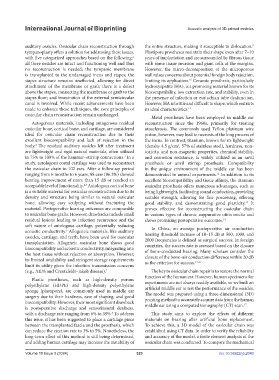Page 331 - IJB-10-3
P. 331
International Journal of Bioprinting Acoustic analysis of 3D-printed ossicles
auditory ossicles. Ossicular chain reconstruction through the entire structure, making it susceptible to dislocation.
9
tympanoplasty offers a solution for addressing these issues, Plastipore prostheses maintain their shape even after 7–10
with five categorized approaches based on the following: years of implantation and are surrounded by fibrous tissue
1
all three ossicles are intact and functioning well and thus with some tissue invasion and giant cells at the margins.
no reconstruction is needed; the tympanic membrane However, the micro-decomposition of the microporous
is transplanted to the undamaged incus and stapes; the wall raises concerns about potential foreign body rejection,
stapes structure remains unaffected, allowing for direct limiting its application. Ceramic prosthesis, particularly
10
attachment of the membrane or graft; there is a defect hydroxyapatite (HA), is a promising material known for its
above the stapes, connecting the membrane or graft to the biocompatibility, low extraction rate, and stability, even in
stapes floor; and fenestration of the external semicircular the presence of infection or eustachian tube dysfunction.
canal is involved. While recent advancements have been However, HA is brittle and difficult to shape, which restricts
made to enhance these techniques, the core principles of its ideal characteristics. 11
ossicular chain reconstruction remain unchanged.
Metal prostheses have been employed in middle ear
Autogenous materials, including autogenous residual reconstruction since the 1960s, primarily for treating
ossicular bone, cortical bone, and cartilage, are considered otosclerosis. The commonly used Teflon platinum wire
ideal for ossicular chain reconstruction due to their piston, however, may lead to necrosis of the long process of
excellent biocompatibility and lack of rejection in the the incus. In contrast, titanium, known for its lightweight
body. The residual auditory ossicles left after treatment (density 4.5 g/cm , 57% of stainless steel), hardness, non-
3
2
are lightweight and rigid natural materials, often utilized toxicity, and non-magnetic properties, chemical stability,
in 75% to 100% of the hammer–stirrup connections. In a and corrosion resistance, is widely utilized as an anvil
3
study, autologous costal cartilage was used to reconstruct prosthesis or anvil stirrup prosthesis. Compatibility
the ossicular chain in 102 ears. After a follow-up period in the unique environment of the middle ear has been
ranging from 6 months to 6 years, 88 ears (86.3%) showed demonstrated in animal experiments. In addition to its
12
hearing improvement of more than 15 dB or reached an excellent biocompatibility and tissue affinity, the titanium
acceptable level of functionality. Autologous cortical bone ossicular prosthesis offers numerous advantages, such as
4,5
is a suitable material for ossicular reconstruction due to its being lightweight, facilitating sound conduction, providing
density and structure being similar to natural ossicular suitable strength, allowing for fine processing, offering
bone, allowing easy sculpting without fracturing the good stability, and demonstrating good plasticity. It
13
material. Postoperative hearing outcomes are comparable proves effective for reconstructing the ossicular chain
to ossicular bone grafts. However, drawbacks include small in various types of chronic suppurative otitis media and
residual lesions leading to infection recurrence and the shows promising postoperative outcomes. 14
soft nature of autologous cartilage, potentially reducing In China, an average postoperative air conduction
acoustic conductivity. Allogeneic materials, like auditory hearing threshold increase of 10–15 dB at 500, 1000, and
6
ossicles, cartilage, and teeth, have been used for ossicular 2000 frequencies is defined as surgical success. In foreign
transplantation. Allogeneic ossicular bone shows good countries, the success rate is assessed based on the closure
biocompatibility and acoustic conductivity, integrating into of bone-conducted hearing. Many scholars consider the
the host tissue without rejection or absorption. However,
its limited availability and stringent storage requirements closure of the bone–air conduction difference within 20 dB
15,16
limit its utility given the infection transmission concerns as the criterion for success.
(e.g., AIDS and Creutzfeldt–Jakob disease). The key to ossicular chain repair is to restore the normal
7
Plastic prostheses, such as high-density porous function of the human ear. However, human specimens for
polyethylene (HDPE) and high-density polyethylene experiments are not always readily available, so we built an
sponge (plastipore), are commonly used in middle ear artificial middle ear to test the performance of the ossicles.
The model was prepared using a three-dimensional (3D)
surgery due to their hardness, ease of shaping, and good printing method to accurately acquire data from the human
biocompatibility. However, their most significant drawback middle ear using a computed tomography (CT) scan. 17
is postoperative discharge and sensorineural deafness,
with a discharge rate ranging from 6% to 39%. To address This study aims to explore the effects of different
8
this issue, it has been suggested to place a cartilage piece materials on hearing after artificial bone replacement.
between the transplanted fascia and the prosthesis, which To achieve this, a 3D model of the ossicular chain was
can reduce the ejection rate to 3% to 5%. Nonetheless, the established using CT data. In order to verify the reliability
long-term effect of this method is still being determined, and accuracy of the model, a finite element analysis of the
and adding human cartilage may increase the instability of ossicular chain was conducted. To compare the mechanical
Volume 10 Issue 3 (2024) 323 doi: 10.36922/ijb.2040

